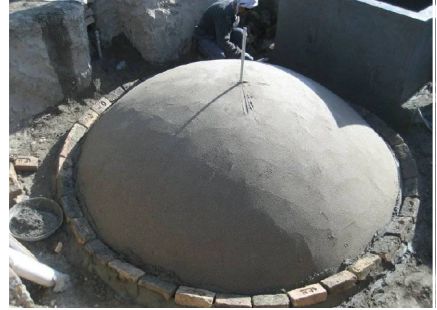Domestic Biogas Plant Construction Complete Guide 5th Part
Proper Construction of Domestic Biogas Plant
So for Goober gas domestic biogas plant construction manual four parts are described, including it’s all contents, introduction, material required, benefits and installation guidelines. Now we are moving towards proper construction of biogas plant. size, construction siteselection and quality standards of construction materials, plant layout of bio gas plant, digging of pit and construction of digester are discussed in previous post, now in this post we will discuss construction of dome, gas holder, plastering of digester and gas holder, construction of turret, manhole and outlet tank.
Construction of Dome, Gas Holder
After construction of round wall digester next step is construction of spherical shape dome/ gas holder over it using cement concrete. Before concrete work, earthen mould/ shuttering in a spherical form using wooden sticks is made. Over it put moist soil, earth mould has the exact shape of the template, a thin layer of fine sand has to be spread on the mould top by gently patting it on the surface.
A concrete mixture with ratio of 1cement, 2 sand, 3 gravel must be made for the mason. The top of the wall has to be applied with cement water slurry before starting the concreting work. The concreting of dome should be started from the top of manhole where a 15 cm thick beam has to be casted to accommodate the foundation for the outlet wall.
Special care should be taken to maintain the thickness of dome while casting, i.e. the thickness in and near the edges should be more than the thickness in the centre. The small pipe on the top of the mould must be left in place till the main gas pipe is installed. This is to make sure that the main gas pipe is exactly in the centre.
After construction of dome/gas holder, the concrete has to be protected against strong sun-light by covering it with jute bags or straw mats. This protection has to be left in place for at least one week. Also from the day after the casting onwards, the dome has to be sprinkled with water 3 to 4 times a day which is known as curing.
Plastering of Digester and Gas Holder
Plastering of digester and gas holder is necessary for the effective functioning of any bio digester. If gas tightness is week gas escapes through the minute pores. The whole investment will therefore be wasted if gas holder is not made perfectly gas-tight.
After approximately one week, depending on the temperature the earth of the mould can be removed through the manhole. When all earth is removed, the surface of the gas holder has to be cleaned with scrubbing with water and iron brush. The entire surface of the concrete dome has to be cleaned before starting the plastering. After cleaning, the following layers of plastering works have to be applied to make the gas holder perfectly gas tight.
5 Layers of Dome Treatment
1) Plain cement water flush having 1 part cement and 5 parts of water, apply with the help of broom.
2) 10 mm thick plastering with cement sand mortar having 1 part of cement and 3 parts of sand apply with plastering trowel.
3) 3 to 5 mm thick cement sand punning having 1part of cement and 2 parts of sand with plastering trowel.
4) Plastering with cement and acrylic emulsion paint mix 1 part paint and 10 parts cement, 3 to 5 mm thick applied with plastering trowel
5) Painting with thick layer of cement, acrylic emulsion paint, 1 part of paint and two parts of cement, apply with painting brush,10 cm wide,
Note: A plaster coat must be well set before applying the next layer. Interval of one day for the third and fourth coat is good for gas-tightness. While applying the plaster layers, the work must be executed with the greatest care and without interruption in between. Each layer has to be smooth and fine. Curing has to be properly done in each surface before applying another layer.
Construction of Turret
Turret is constructed to protect the dome gas pipe. The day after the casting, the turret must be made. Any delays can lead to leakage between main gas pipe and dome.
The construction of turret has to be done when the concrete in the outer surface of the gas holder sets well. The size of the turret should be decided based upon the size of stone and brick. The size of square should be at least 20 cm. The height of turret should be at least 40 cm. Turret could be constructed of concrete.
Construction of Outlet tank
To construct the outlet tank/ as displacement chamber, excavation has to be done just behind the manhole. It is important to accurately comply with the dimensions of the tank as they determine the useful capacity of the gas holder.
The depth of exaction should be inner depth of outlet plus the thickness of plaster plus thickness of flooring form the ground level. When excavated at this depth, the top level of flooring would exactly reach at the top of manhole.
The earth in the base of outlet, behind the manhole has to be well compacted otherwise cracks will appear in the outlet floor later on. The inside dimension of outlet chamber can be found on the drawing under length, breadth and depth. The length and breadth of digging should be the inner dimension plus wall thickness plus plaster layer. Ensure that the distance from the floor of the manhole to finished floor of the outlet is equal to height ‘Hop’ in the drawing.
The earth in the base of outlet, behind the manhole has to be well compacted otherwise cracks will appear in the outlet floor later on. The inside dimension of outlet chamber can be found on the drawing under length, breadth and depth. The length and breadth of digging should be the inner dimension plus wall thickness plus plaster layer. Ensure that the distance from the floor of the manhole to finished floor of the outlet is equal to height ‘Hop’ in the drawing.
Once the excavation is completed, compact the floor and lay broken stones or broken bricks on the floor. After properly compacting the stone or brick floor, lay a thick layer of course cement sand mortar mixture with ratio of 1 and 4. The finished surface should be levelled and smooth. In this surface, once the mortar is set, outlet walls have to be constructed. The inner dimensions of outlet should be as shown in drawing. While fixing the dimensions allow 1.5-2 cm for plastering, in each side. Lay a first layer of mortar, 1cement, 3 sand, and start constructing wall. First, place bricks in the four corners of the tank wall and fix a rope to guide the brick work by tying it with the bricks in either side. The walls have to be vertical and finished with a smooth layer of cement plaster,1 cement, 3sand. The outer part of the wall has to be compacted well to avoid cracks due to slurry pressure from inside. There is no need of plastering the outside of the outlet tank walls.
The overflow level in outlet wall should be in higher elevation than the natural ground level. This is done to avoid the surface run off from the surrounding areas to enter into the outlet, especially in the rainy season.
It is better to orient outlet in such a manner that the length is parallel to the hart-line. If there is limitations of land than it can be done in the other way. Always construct the overflow in the shorter wall.
The cover slab for outlet should be casted during the concreting of gas holder. The slab could be casted on levelled ground as per the dimensions given for different capacity of plants. Special care has to be given to compact the concrete mix while casting slab as small holes left behind will expose the steel reinforcement to corrosive vapour coming from the slurry in the outlet tank. This vapour will lead to corrosion of reinforcement and in longer run the slab may ultimately collapse. Even if some holes are created, these should be closed with a layer of plaster.
The slab should be cured daily for at least 5 days before it is placed into its location. The slab must be more than 5.5 cm thick with proper reinforcement of 2 cm from the bottom. The slab must be of size that could be handled by 3-4 people without great difficulty. The outlet cover slabs are very essential to protect people especially the children and animal from falling inside. Furthermore it stops the rainwater entering into the digester and also helps in avoiding excessive vaporization of slurry in the dry and hot season.
The Dimensions of outlet Slabs
The slab should be cured daily for at least 5 days before it is placed into its location. The slab must be more than 5.5 cm thick with proper reinforcement of 2 cm from the bottom. The slab must be of size that could be handled by 3-4 people without great difficulty. The outlet cover slabs are very essential to protect people especially the children and animal from falling inside. Furthermore it stops the rainwater entering into the digester and also helps in avoiding excessive vaporization of slurry in the dry and hot season.
The Dimensions of outlet Slabs

























